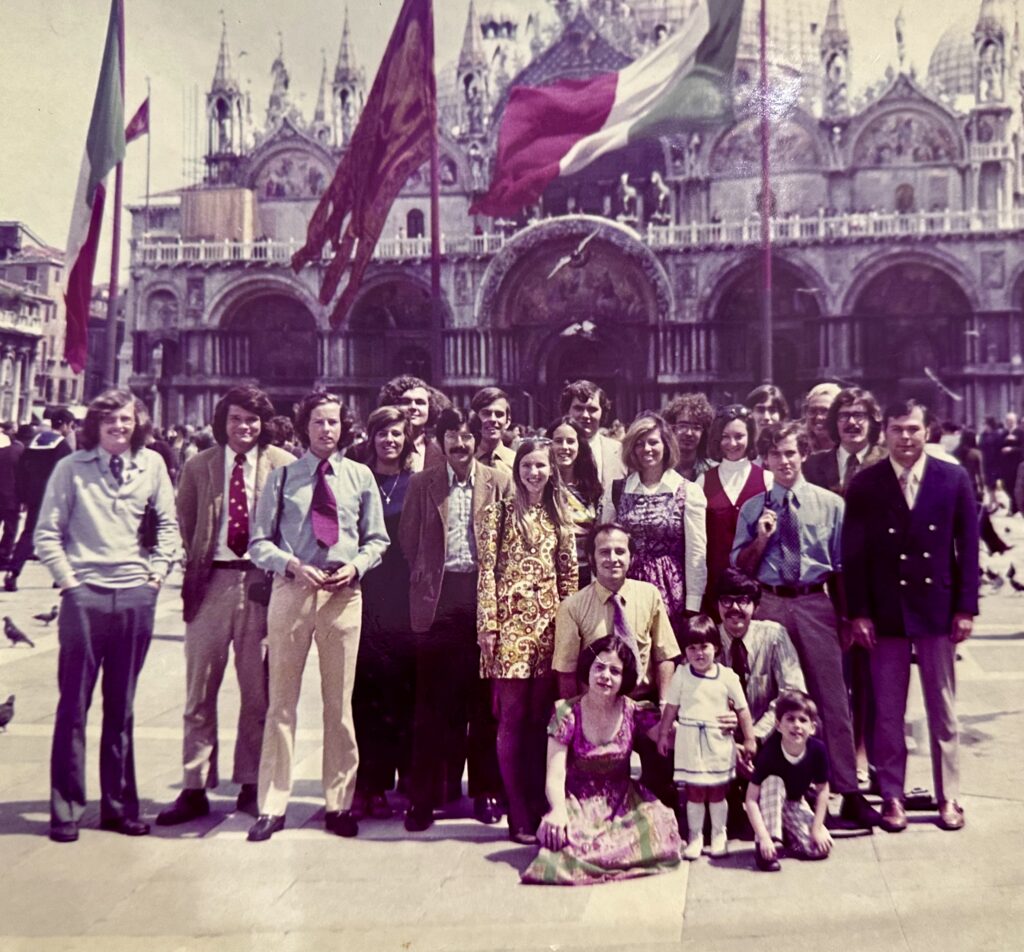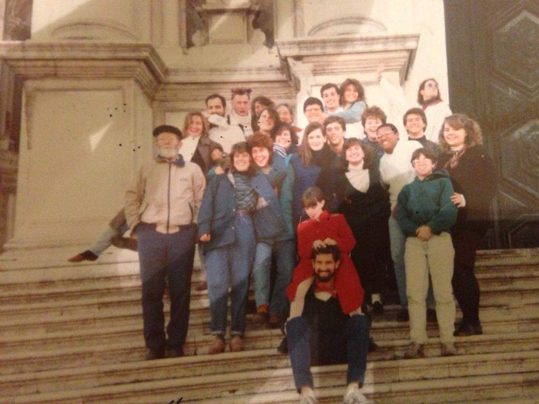Reflections of Casa Artom
Andy and Grace Andronica



Our first glance out the window of Casa Artom was in 1971-72 when my wife Grace, son Matthew and daughter Kristina (age 4 and 2, respectively), and I joined two groups of students in Venice to participate in the inaugural year of Wake Forest’s residential study abroad program. Later we returned to direct the program in Spring 1981 and Fall 1992. We welcomed the opportunity to interact again with students in the adventure to explore ways to weave Venice and study abroad into a fabric of cultural and personal experience.
We used course-related and personal travel to supplement the core courses in language and art, whether on day trips to the Veneto for Dr. Pignatti’s lectures on Tiepolo, Giorgione, Veronese, et al., or on excursions that highlighted aspects of my Classics course offerings on literature, myth, and history. There was free time to pursue and explore personal interests (or discover new ones) at local museums, galleries, shops, and places of popular attraction. We traveled to Rome and surroundings to study ancient sites and monuments (including the Roman Forum, Palatine Hill, Colosseum, Nero’s Golden House, and imperial fora); to Cerveteri and Tarquinia to explore Etruscan tombs and funeral remains; to Florence where we attended a private showing of the Riace Warriors (the two famous full-size naked Greek bronzes recovered in 1972 from the sea off the coast of Calabria and soon thereafter placed in early stages of restoration and conservation); and from there we traveled to neighboring Fiesole to visit and explore the local Roman amphitheater.
Field trips were not all study and no play. On one occasion during a stay at a pensione on Via Nazionale in Rome, several students decided to relax after a long day by doing impromptu late-night clog dancing — the loud clatter of which, together with a high volume of enthusiastic audience approval, did not escape the notice of the night clerk on duty. The circumstances of this event were far different from those in 1992 when students and faculty traveled to the American Embassy at Rome to vote by absentee ballot in the presidential election; our presence then went virtually unnoticed.
Casa Artom was a focal point for events and cultural programs that celebrated Wake Forest’s presence and encouraged participation by a wider resident community of non-Italians and native Venetians. We established a social network with nearby Ca’ Foscari University to help students improve their bilingual ability; we often supported activities and events sponsored by Circulo Italiano, the organization of the resident Anglo-American community, notably on a special occasion in 1972 when Casa Artom hosted a stage performance of several Harold Pinter plays presented by a troupe of traveling troubadours from England much to the delight of a large audience, including notables Sir Kenneth Clark, Peggy Guggenheim, and Ezra Pound.
From time to time we planned a communal meal. It was a special occasion to come together in ‘food camaraderie’ to develop culinary and language skills. Students prepared the menu and purchased food in local shops and at the Rialto, where they conducted business in Italian (sometimes aided by hand gestures!) with vendors, most of whom did not speak English.
One of the most daunting meals was Thanksgiving of 1992. We wanted it to be traditional but soon discovered that we would not be able to find many of the ingredients needed (though for those who preferred a vegan fare, the menu was less challenging). Fortunately, there were several parents who planned to travel to Venice to spend Thanksgiving with their children. With the menu set, we asked parents to bring ingredients unavailable locally, including cranberries, pecans, Karo syrup, and tapioca. We made special arrangements with the owner of the neighborhood panificio to use one of the baking ovens to roast the turkey. Unfortunately, the oven designated for our use was too small to accommodate our twenty-seven pound turkey. And so, to preserve the centerpiece of the anticipated feast we made a difficult decision — we divided ‘Tom’ in half, stuffing and all. Casa Artom was blessed that Thanksgiving with many good cooks and bakers who prepared a delicious array of food for the thirty-five or so who participated.
Although we prepared and ate most of our meals at Casa Artom, dining out was a favorite way to explore and enjoy a variety of food in the Italian and Venetian cuisine. There were always stories to share about the discovery of new menu items or places to eat. It was on one such occasion when time and circumstance would combine to make memories, as happened one evening at Trattoria ai Cugnai in the season of ‘aqua alta’ when waiters wearing rain boots served us as we sat similarly dressed and dined at tables weighted down at the corners with pieces of tile or stone for stability.
At times we encountered Venice’s other seasonal phenomena: fog and snow. Faculty and students went on an adventure whenever they departed from Venice under adverse weather conditions to travel to out-of-town destinations to participate in scheduled course activities. Travel to the train station at Santa Lucia on the Grand Canal was easy enough under normal circumstances, but in hazardous weather when transportation by vaporetto and motoscafo was suspended because of near zero visibility, passage on foot (in good weather about a twenty-five minute walk from Casa Artom) was cautious and slow. And so, we stayed close together to find a way through winding streets and over arched bridges to arrive safely and on schedule at the station. On other occasions of severe weather, we went to St. Mark’s Square where, as instinct or courage prompted, we could wade in the tidal overflow of the Grand Canal or trudge through the snow cover of a winter storm.
We have very fond memories of the Casa Artom program. It broadens horizons, builds bonds of friendship, enlivens and enriches experience, and changes lives. It is an adventure in waiting.
John (Andy) and Grace Andronica
(written November 2022)

July 16, 2020, Reflection as shared with Dr. Hairston’s colleagues in the Office of the Dean of the College
Thirty years ago (it pains me to write that), I was a rising Wake Forest junior, preparing to embark for Venice. Casa Artom awaited, along with experiences that altered the course of my life. Those memories are stronger now than usual, both because it has been thirty years and because of the sense of loss I feel for those whose travels have been interrupted by the COVID-19 pandemic and travel shutdowns. It wasn’t supposed to be this way . . . or so one is tempted to think.
Sometimes I have to remind myself that I had no intention of leaving the U.S. a few months prior to August 1990. I was embroiled in the usual undergraduate dramas and concerns and quite certain that I had Wake Forest and the world fully figured out. I knew how to navigate the campus and classes. I had found the sophisticated West End hangouts. And, I knew how to move about Winston-Salem while keeping a safe distance from the police. Don’t think for a minute that there is anything new under the sun.
My confidence aside, one Associate Dean and one young English professor had both determined that I needed to get out into the world, and they told me that I was going to either London or Venice – yes, told me. The next thing I knew, I was in an intensive Italian class and trying to figure out how my life had changed so much so quickly. Even my conservative parents accepted the idea. I tried to tell them that there were likely no Baptist churches for me to attend in Italy, which normally would have decided the issue, but there was nothing normal about 1990. In August, I was on a plane with a group of people who were mostly strangers, many of whom were greek-affiliated and utterly foreign to my Huffman House sensibilities. Moreover, I was a young black man abroad and not quite sure if I was safer in North Carolina or in the city that did Othello dirty.
Venice was and is magical, and I can add nothing to the many words written of it. Many of my dearest friendships, greatest mentorships, and most transformative intellectual experiences began there. The next thirty years were a direct result of those five totally unplanned, disruptive months in 1990. I never would have plotted that trajectory, would have feared the very idea, would not have known how to prepare, and would have bet money against it ever happening – and then it did. This unexpected turn of events changed everything.
One episode seems oddly appropriate in relation to where we all find ourselves now. The late Don Johansson, the husband of then Associate Dean Pat Johansson, designed a large set of individual walks through the city. On any given day, students ventured out with those pages in hand, seeking out the landmarks and vistas he noted. One day I joined a group on one of those walks. Don had written that if one carefully leaned over and looked down the canal at a key spot, beautiful Byzantine-era columns could be seen set into a wall. We had our directions, we knew exactly what to find, and nothing went as planned. We missed a turn, a calle was blocked, and there were other errors.
When we finally arrived, a student leaned over to look just as I did. He jerked suddenly as wet stone carried one foot out from under him. I reached to catch him, he steadied himself, and I went tumbling into the canal. Ironically, he was a lifeguard and I was a mediocre swimmer. I’m told that I flipped and went in feet first. I remember sinking into the greenish but pretty clear water and looking down the length of the canal. I also remember thinking: 1) This is not good, and I’m probably going to die 2) This wouldn’t be happening to me at Carolina 3) It is amazingly beautiful down here.
It turns out that the Byzantine architecture ran all along under the water as well, along with fish, seaweed, and me. I didn’t actually think of kicking up to the surface until I hit what I suppose was the bottom, and I watched the scenery all the way back up to the light. I was still damp when we reached Casa Artom, and nobody has let me forget the incident, but I would not trade for anything that unexpected bath, in an unintended location, in an unintended part of my life.
July 1,2020 marked the end of my first year at Wake Forest as Associate Dean in the Office of Academic Advising. One of my great joys this year was to have a long advising talk with the child of one of my Casa Artom classmates. I should have taken that as a sign, because true to form, just when I thought I was getting the hang of things at Wake Forest, the world shifted and I was once again plunged into the canal. Once again, I am, like all of us, adjusting to the surprising, submerged state and seeing unexpected things. We have all been plunged into an unexpected place, in an unintended present, with a now altered future. We are all well past being ready to kick to the surface, but as we do, it might be worthwhile to look at what is around us and what new things we have found. Some are well worth bringing back to the surface with us to make a part of the rest of our lives.
